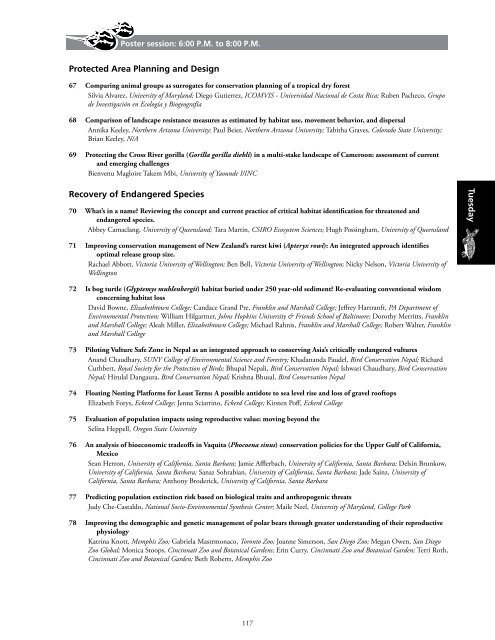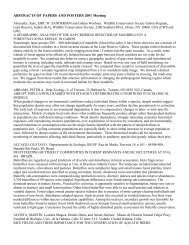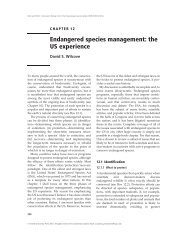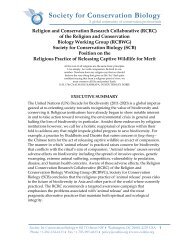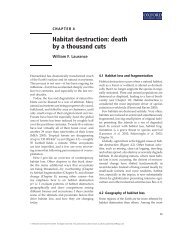ICCB 2013 Program - Society for Conservation Biology
ICCB 2013 Program - Society for Conservation Biology
ICCB 2013 Program - Society for Conservation Biology
You also want an ePaper? Increase the reach of your titles
YUMPU automatically turns print PDFs into web optimized ePapers that Google loves.
Poster session: 6:00 P.M. to 8:00 P.M.<br />
Protected Area Planning and Design<br />
67 Comparing animal groups as surrogates <strong>for</strong> conservation planning of a tropical dry <strong>for</strong>est<br />
Silvia Alvarez, University of Maryland; Diego Gutierrez, ICOMVIS - Universidad Nacional de Costa Rica; Ruben Pacheco, Grupo<br />
de Investigación en Ecología y Biogeografía<br />
68 Comparison of landscape resistance measures as estimated by habitat use, movement behavior, and dispersal<br />
Annika Keeley, Northern Arizona University; Paul Beier, Northern Arizona University; Tabitha Graves, Colorado State University;<br />
Brian Keeley, N/A<br />
69 Protecting the Cross River gorilla (Gorilla gorilla diehli) in a multi-stake landscape of Cameroon: assessment of current<br />
and emerging challenges<br />
Bienvenu Magloire Takem Mbi, University of Yaounde I/INC<br />
Recovery of Endangered Species<br />
70 What’s in a name Reviewing the concept and current practice of critical habitat identification <strong>for</strong> threatened and<br />
endangered species.<br />
Abbey Camaclang, University of Queensland; Tara Martin, CSIRO Ecosystem Sciences; Hugh Possingham, University of Queensland<br />
Tuesday<br />
71 Improving conservation management of New Zealand’s rarest kiwi (Apteryx rowi): An integrated approach identifies<br />
optimal release group size.<br />
Rachael Abbott, Victoria University of Wellington; Ben Bell, Victoria University of Wellington; Nicky Nelson, Victoria University of<br />
Wellington<br />
72 Is bog turtle (Glyptemys muhlenbergii) habitat buried under 250 year-old sediment Re-evaluating conventional wisdom<br />
concerning habitat loss<br />
David Bowne, Elizabethtown College; Candace Grand Pre, Franklin and Marshall College; Jeffrey Hartranft, PA Department of<br />
Environmental Protection; William Hilgartner, Johns Hopkins University & Friends School of Baltimore; Dorothy Merritts, Franklin<br />
and Marshall College; Aleah Miller, Elizabethtown College; Michael Rahnis, Franklin and Marshall College; Robert Walter, Franklin<br />
and Marshall College<br />
73 Piloting Vulture Safe Zone in Nepal as an integrated approach to conserving Asia’s critically endangered vultures<br />
Anand Chaudhary, SUNY College of Environmental Science and Forestry; Khadananda Paudel, Bird <strong>Conservation</strong> Nepal; Richard<br />
Cuthbert, Royal <strong>Society</strong> <strong>for</strong> the Protection of Birds; Bhupal Nepali, Bird <strong>Conservation</strong> Nepal; Ishwari Chaudhary, Bird <strong>Conservation</strong><br />
Nepal; Hirulal Dangaura, Bird <strong>Conservation</strong> Nepal; Krishna Bhusal, Bird <strong>Conservation</strong> Nepal<br />
74 Floating Nesting Plat<strong>for</strong>ms <strong>for</strong> Least Terns: A possible antidote to sea level rise and loss of gravel rooftops<br />
Elizabeth Forys, Eckerd College; Jenna Sciarrino, Eckerd College; Kirsten Poff, Eckerd College<br />
75 Evaluation of population impacts using reproductive value: moving beyond the<br />
Selina Heppell, Oregon State University<br />
76 An analysis of bioeconomic tradeoffs in Vaquita (Phocoena sinus) conservation policies <strong>for</strong> the Upper Gulf of Cali<strong>for</strong>nia,<br />
Mexico<br />
Sean Herron, University of Cali<strong>for</strong>nia, Santa Barbara; Jamie Afflerbach, University of Cali<strong>for</strong>nia, Santa Barbara; Delsin Brunkow,<br />
University of Cali<strong>for</strong>nia, Santa Barbara; Sanaz Sohrabian, University of Cali<strong>for</strong>nia, Santa Barbara; Jade Sainz, University of<br />
Cali<strong>for</strong>nia, Santa Barbara; Anthony Broderick, University of Cali<strong>for</strong>nia, Santa Barbara<br />
77 Predicting population extinction risk based on biological traits and anthropogenic threats<br />
Judy Che-Castaldo, National Socio-Environmental Synthesis Center; Maile Neel, University of Maryland, College Park<br />
78 Improving the demographic and genetic management of polar bears through greater understanding of their reproductive<br />
physiology<br />
Katrina Knott, Memphis Zoo; Gabriela Mastrmonaco, Toronto Zoo; Joanne Simerson, San Diego Zoo; Megan Owen, San Diego<br />
Zoo Global; Monica Stoops, Cincinnati Zoo and Botanical Gardens; Erin Curry, Cincinnati Zoo and Botanical Garden; Terri Roth,<br />
Cincinnati Zoo and Botanical Garden; Beth Roberts, Memphis Zoo<br />
117


